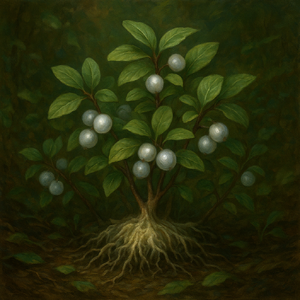Brainberry
| Brainberry | ||||||||||||
|---|---|---|---|---|---|---|---|---|---|---|---|---|
| ||||||||||||
The Brainberry seems like a normal berry bush on the surface, yet it hides a secret. The berries themselves are poisonous, and it is ill-advised to ingest them, as eating one of these berries will cause hallucinations of nightmarish scenarios. This will also cause the user to lose track of time and space, often causing sleepwalking or sporadic movements while under the influence of those fungi. While such may be the case, many prophetic figures claim to have seen visions of the future while being under the influence of these fungi, yet red herrings are the most common occurrences, instead of the visions actually holding any truths to themselves.
Appearance
The Brainberry plant appears as a regular berrybush with silvery berries growing from it. However, one should do so wisely so as not to be fooled by the plant’s appearance, as the plant is in reality a large fungus. The small shrub never grows taller than two feet; the foliage appears to be like many other plants with its green and oval-shaped leaves. Unlike other berries, there are no seeds to be found in the berries or the roots. The spores released from the fungi are produced from the leaves themselves instead.
Many question how and why the fungus has taken on the appearance of a berrybush. Some suspect it's a way to spread the spores, and some suspect it may be a way of disguising itself. The first theory is the most logical, as the fungus releases spores when it is disturbed. The spores tend to cling to animal fur and detach when the animal brushes its fur against another plant, ground or any other surface. The fungi accomplish this by emitting a strong sweet scent when they approach their fruiting cycle, attracting animals to the vicinity of the fungi. Whilst consuming the berries, the leaves of the fungi get disturbed, resulting in the release of the spores onto the animal, which then spreads the spores to new regions through travel.
The fungi seem to grow the best on vertical surfaces, but have been seen to grow on nearly any surface, even on the ceilings of old abandoned buildings and ruins. This innate ability to cling to anything is thanks to small roots that extend from the branches of the fungi. These branches emit a small amount of sticky substance that acts like an anchor for the fungi, allowing them to cling to most surfaces. Due to the quick drying of the substance, it has not been able to be used as any sort of glue or sealant.
Impact on the Ecosystem
The Brainberry has a mixed impact on the local ecosystem. The fungi themselves can also latch onto other plants or wet plant materials, such as fallen leaves, wet wood beams and more, leaching the minerals and water out of the host material, resulting in breaking down the plant matter or killing the host plant. Most commonly, the fungi attach themselves to trees; however, in more recent years, the fungi have attached themselves to crops planted by farmers, which has resulted in crop failure. Due to the fast-growing nature of this fungus, it can quickly overtake a farm, causing large portions of fields to die out.
Yet the berries are a source of nutrients for passing by animals, even with the hallucinatory effects. At the same time, the sticky substance, which the fungi use to attach themselves to surfaces, acts as a sap for small insects to feast upon before it dries out and turns into its hardened state. Whilst feeding on the sap during the fruiting cycle, the insect may also have spores attached to it when disturbing the leaves during their attempt to consume the delicious sap. This makes the fungi less dependent on larger animals to survive and allows them to thrive in nearly any environment, so long as there is humidity.
Usage
The berries of the fungus cause hallucinations upon ingesting them. Depending on the amount, the effects can range from mild hallucinations to severe paranoia, through nightmarish hallucinations. If ingested before going to sleep, people also start to suffer from sleepwalking, resulting in strange situations of waking up in other rooms or even outside of one's own home. Yet, one thing remains the same: those who have ingested the fungi proclaim to have seen visions of the future, yet said visions are often mere dreams influenced by the imagination of the consumer. Despite its hallucinogenic effect, the fungus remains a valid source of food for many animals and insects alike, which either eat the berries of the fungi or drink their sap.
| Navigation - Plants & Fungi | ||||||||||||||||||||||||||||||
|---|---|---|---|---|---|---|---|---|---|---|---|---|---|---|---|---|---|---|---|---|---|---|---|---|---|---|---|---|---|---|
| ||||||||||||||||||||||||||||||
